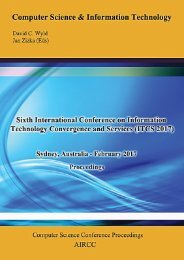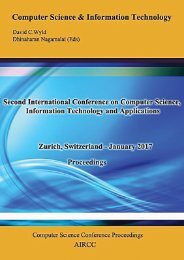CoSIT 2017
Fourth International Conference on Computer Science and Information Technology ( CoSIT 2017 ), Geneva, Switzerland - March 2017
Fourth International Conference on Computer Science and Information Technology ( CoSIT 2017 ), Geneva, Switzerland - March 2017
Create successful ePaper yourself
Turn your PDF publications into a flip-book with our unique Google optimized e-Paper software.
106 Computer Science & Information Technology (CS & IT)<br />
The new thing we come up with here is working with a full non-prime moduli set ( i.e. for this<br />
case ) gcd (mi, mj ) ≠ 1 for i ≠ j (1)<br />
RNS systems based on non coprime moduli have also been studied in literature [2] –[5].<br />
Although as discussed in [2] that non-coprime has little studies upon, we still have strong sense<br />
that it deserves to work on.<br />
The rest of this paper is organized as follows. In Section 2, overview of the new Non-coprime<br />
multi moduli is proposed. Section 3 presents the realization of the proposed forward converter of<br />
the new non-coprime conjugate-pair multi-moduli , while the paper is concluded in Section 4.<br />
2. OVERVIEW OF NEW NON-COPRIME MULTI –MODULI<br />
Since almost all previous work stated that [1][3][5] " The basis for an RNS is a set of relatively<br />
prime integers; that is :<br />
S = { q 1<br />
, q 2<br />
, ... , q L<br />
}, where (q i<br />
, q j<br />
) = 1 for i ≠j (2)<br />
with (qi , qj ) indicating the greatest common divisor of qi and qj .<br />
The set S is the moduli set while the dynamic range of the system ( i.e. M ) is the product Q of the<br />
moduli qi in the set S. Any integer X belonging to ZQ = { 0, 1 2, .... , Q -1 } has an RNS<br />
representation" .<br />
X<br />
RNS<br />
( X 1 , X 2 , … , X L ) (3)<br />
X i = < X > qi<br />
, i = 1, 2, .... , L (4)<br />
Where q<br />
is X mod q.<br />
For our case of non-coprime , equation number 4 becomes :<br />
X i = < X > qi<br />
, i = 2, 3, .... , L (5)<br />
For both cases ( i.e. Coprime and Non-coprime ), if X, Y have RNS representations { X1, …..,<br />
XM}, { Y1, … , YM}, the RNS representation of W = X * Y ( * denotes addition, subtraction or<br />
multiplication ) is<br />
W RNS { W1, …. , WM }; Wi = < Xi * Yi > qi, i = 1, … , L (6)<br />
Another thing to notice here is that our new proposed non-coprime conjugate-pair multi-moduli<br />
set is also conjugate even by dividing it by the common factor among its moduli ( i.e. number 2 in<br />
this case), the shape is to be discussed in another paper. However it has the following form :





